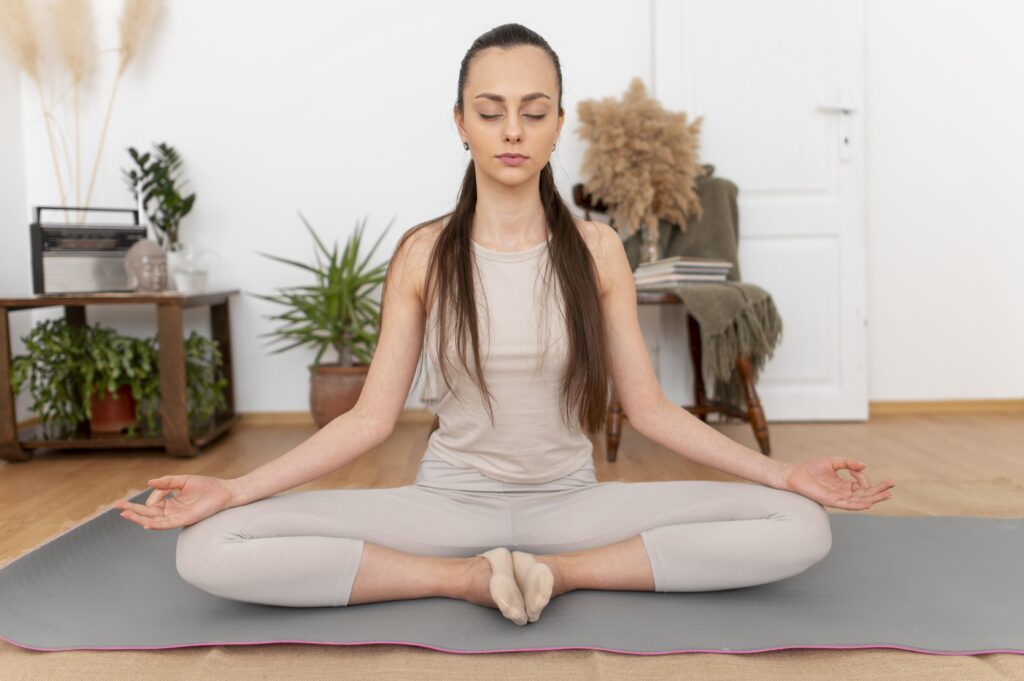Stress management is important for a healthy life. Many people feel stress from work, family, or daily worries. Yoga poses for stress relief can help you relax and feel better. In addition, naturopathy offers natural ways to support your mind and body. When you combine yoga and simple lifestyle changes, you can manage stress more easily. This guide will show you how yoga, along with healthy habits, can help you find calm and balance.
Understanding Stress and Its Impact
Stress is your body’s response to challenges or demands. Sometimes, stress can help you stay alert. However, too much stress can harm your health. It may cause headaches, trouble sleeping, or even stomach problems. Over time, stress can also affect your mood and energy. For example, you might feel tired, worried, or sad. According to the World Health Organization (WHO), long-term stress can increase the risk of heart disease and other health issues. Therefore, learning to manage stress is very important for your well-being.
How Yoga Helps in Stress Management
Yoga is an ancient practice that combines movement, breathing, and relaxation. Many studies show that yoga can lower stress and improve mood. For instance, the Centers for Disease Control and Prevention (CDC) notes that yoga helps reduce anxiety and supports mental health. When you practice yoga, your body releases feel-good chemicals called endorphins. These chemicals help you feel calm and happy. In addition, yoga teaches you to focus on your breath. This can slow your heart rate and relax your muscles. As a result, yoga is a safe and natural way to manage stress.
Top Yoga Poses for Stress Relief
Many yoga poses can help you relax and reduce stress. Below are five effective yoga poses for stress relief. Try to practice them in a quiet space.
1. Child’s Pose (Balasana)
Kneel on the floor and sit back on your heels.Next, lower your forehead to the mat.Stretch your arms forward or rest them by your sides.Breathe deeply and hold for 1–3 minutes.
Benefits: Child’s Pose calms the mind and eases tension in the back and shoulders.
2. Cat-Cow Pose (Marjaryasana-Bitilasana)
Start on your hands and knees.Inhale and arch your back, lifting your head and tailbone (Cow Pose).Exhale and round your back, tucking your chin (Cat Pose).Repeat slowly for 1–2 minutes.
Benefits: This pose gently stretches your spine and helps release stress.
3. Legs-Up-the-Wall Pose (Viparita Karani)
Sit close to a wall and lie on your back.Lift your legs up and rest them against the wall.Keep your arms relaxed by your sides.Breathe slowly and stay for 5–10 minutes.
Benefits: Legs-Up-the-Wall Pose improves blood flow and calms the nervous system.
4. Standing Forward Bend (Uttanasana)
Stand with your feet hip-width apart.Exhale and bend forward from your hips.Let your head and arms hang down.Hold for 30 seconds to 1 minute.
Benefits: This pose helps release tension in your back and neck.
5. Corpse Pose (Savasana)
Lie flat on your back with your arms at your sides.Close your eyes and relax your whole body.Focus on your breath and stay for 5–10 minutes.
Benefits: Corpse Pose helps your body and mind fully relax after yoga practice.
Tips for Practicing Yoga Safely
Before you start yoga, keep these tips in mind for a safe and enjoyable practice:Start with simple poses and move slowly.Listen to your body and stop if you feel pain.Use a yoga mat for comfort and safety.Practice in a quiet, clean space.Stay consistent by practicing a few times each week.Ask a certified yoga instructor for help if you are unsure.
Remember, everyone’s body is different. If you have health problems, talk to your doctor before starting yoga.
Lifestyle and Nutrition Tips for Stress Management
Along with yoga, simple lifestyle and nutrition changes can help manage stress. Naturopathy suggests these easy tips:Eat fresh fruits and vegetables every day.Drink enough water to stay hydrated.Get enough sleep each night.Spend time outdoors in nature.Practice deep breathing or meditation daily.Limit caffeine and processed foods.
These habits support your body’s natural ability to handle stress.
Prevention and Long-Term Stress Management
Preventing stress is easier than treating it later. Try these long-term habits for better wellness:Set a regular routine for sleep and meals.Take breaks during work or study.Connect with friends and family often.Exercise regularly, even with simple walks.Keep a journal to write down your thoughts.Practice gratitude by noting things you are thankful for.
Over time, these habits can help you feel more balanced and less stressed.
Conclusion & Call-to-Action
In summary, yoga poses for stress relief are simple and effective tools for managing daily stress. When you add healthy habits and good nutrition, you support your mind and body even more. For best results, consult a certified yoga instructor or wellness specialist. They can guide you with safe and personalized stress management advice.



